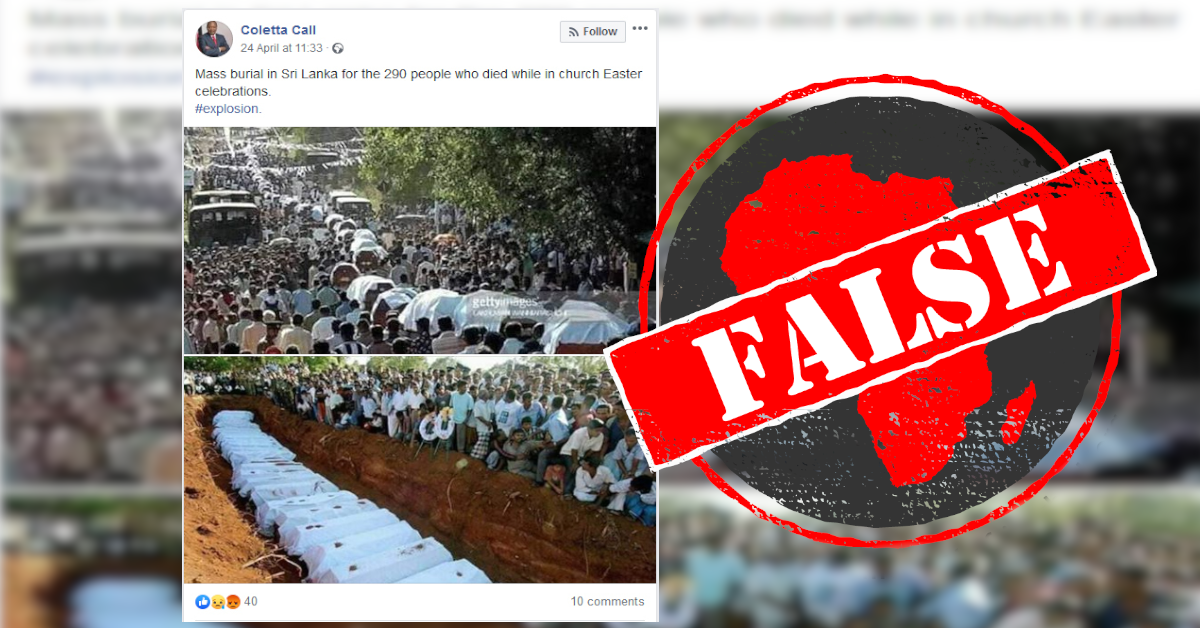On 21 April 2019, Easter Sunday, three churches and three hotels in Sri Lanka were almost simultaneously hit by coordinated bomb blasts that killed at least 253 people and wounded 500 more.
Photos of the bombings quickly flooded social media. But not all actually showed the devastating attacks.
Two falsely captioned photos were posted on 24 April 2019 by a Facebook user with more than 21,000 followers.
The first shows hundreds of draped coffins being carried through a massive crowd of people. In the second, a long line of coffins lie in a mass grave.
The post’s caption reads: “Mass burial in Sri Lanka for the 290 people who died while in church Easter celebrations.”
Another Facebook user posted the photos to their 2,000 followers on 22 April.
Here the caption says: “You can see in the photo below a scene from the funeral that was held today at Zion Church for the victims of the Easter bombing. Most of those who were killed at Zion Church were children.”
The photos have also been shared on group pages from Kenya and Zambia.

The photos are of a mass funeral for bomb victims in Sri Lanka – 13 years ago.
A reverse image search reveals that they show the aftermath of a 15 June 2006 bus bombing blamed on the Tamil Tigers (also known as the Liberation Tigers), a Sri Lankan rebel group. The Tigers were defeated by the country’s army in 2009 after more than two decades of civil war.
Photographer Lakrunwan Wanniarachchi took the photos on 16 June 2006 for global news agency Agence France Presse, or AFP.
AFP’s caption for the first photo says mourners were carrying the coffins of 61 people killed in a bomb attack at Kebitogollewa in north-central Sri Lanka.
A powerful landmine had ripped through an overcrowded bus on 15 June 2006, killing a total of 64 people – 15 of them children – and wounding 80 others.
The watermark on the photo shows it’s also licensed by Getty Images.
The second photo is of the victims being laid to rest.
The Facebook posts have been checked by AFP Fact Check, who rated them inaccurate. – Dancan Bwire (15/05/19)
Photos of the bombings quickly flooded social media. But not all actually showed the devastating attacks.
Two falsely captioned photos were posted on 24 April 2019 by a Facebook user with more than 21,000 followers.
The first shows hundreds of draped coffins being carried through a massive crowd of people. In the second, a long line of coffins lie in a mass grave.
The post’s caption reads: “Mass burial in Sri Lanka for the 290 people who died while in church Easter celebrations.”
Another Facebook user posted the photos to their 2,000 followers on 22 April.
Here the caption says: “You can see in the photo below a scene from the funeral that was held today at Zion Church for the victims of the Easter bombing. Most of those who were killed at Zion Church were children.”
The photos have also been shared on group pages from Kenya and Zambia.

Bomb attack during Sri Lankan civil war
The photos are of a mass funeral for bomb victims in Sri Lanka – 13 years ago.
A reverse image search reveals that they show the aftermath of a 15 June 2006 bus bombing blamed on the Tamil Tigers (also known as the Liberation Tigers), a Sri Lankan rebel group. The Tigers were defeated by the country’s army in 2009 after more than two decades of civil war.
Photographer Lakrunwan Wanniarachchi took the photos on 16 June 2006 for global news agency Agence France Presse, or AFP.
AFP’s caption for the first photo says mourners were carrying the coffins of 61 people killed in a bomb attack at Kebitogollewa in north-central Sri Lanka.
A powerful landmine had ripped through an overcrowded bus on 15 June 2006, killing a total of 64 people – 15 of them children – and wounding 80 others.
The watermark on the photo shows it’s also licensed by Getty Images.
The second photo is of the victims being laid to rest.
The Facebook posts have been checked by AFP Fact Check, who rated them inaccurate. – Dancan Bwire (15/05/19)
Republish our content for free
For publishers: what to do if your post is rated false
A fact-checker has rated your Facebook or Instagram post as “false”, “altered”, “partly false” or “missing context”. This could have serious consequences. What do you do?
Click on our guide for the steps you should follow.
Publishers guideAfrica Check teams up with Facebook
Africa Check is a partner in Meta's third-party fact-checking programme to help stop the spread of false information on social media.
The content we rate as “false” will be downgraded on Facebook and Instagram. This means fewer people will see it.
You can also help identify false information on Facebook. This guide explains how.


Add new comment